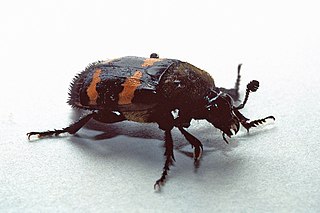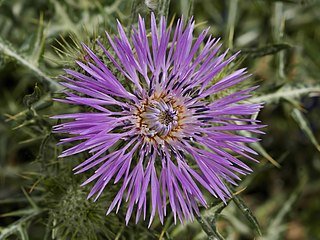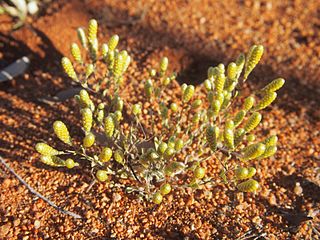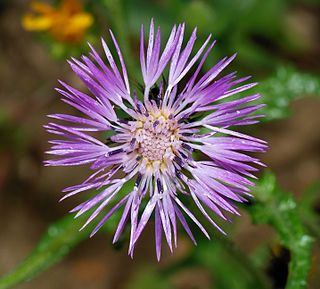
The raspberry beetle is a species of beetle in the fruitworm family Byturidae. It is a major pest that is widespread in north-central Europe, affecting raspberry, blackberry and loganberry plants.

The woolly giant rat is a species of large burrowing rodent native to South America. No subspecies are currently recognised. It is the only member of the genus Kunsia.

Nicrophorus tomentosus is a species of burying beetle that was described by Friedrich Weber in 1801. The beetle belongs to the family Silphidae which are carrion beetles. The beetles have sensitive antennae that contain olfactory organs. Thus, the beetle can locate dead animals (carcass), and then as the name suggests, can bury them. However, unlike other burying beetles, N. tomentosus does not completely bury these brood carcasses. They instead dig a shallow hole under the carcass and cover it with leaf litter. Recognition of these beetles can be distinguished by its black color with orange markings on the wing covers (elytra).

Ceanothus tomentosus, with the common name woollyleaf ceanothus, is a species of shrub in the family Rhamnaceae. It is characterized by pale-blue to deep blue flowers and wooly leaves. It is native to California and Baja California, having an unusual disjunct distribution in the Peninsular Ranges and the north-central Sierra Nevada.

Galactites is a genus of flowering plants in the family Asteraceae. The name is derived from the Greek γάλα. The best-known species is Galactites tomentosus.

Angianthus is a genus of flowering plants in the family Asteraceae, which was first described by Wendland in 1810. The type species is Angianthus tomentosus.

Suillus tomentosus is a species of mushroom. The common names of the species are blue-staining slippery jack, poor man's slippery Jack, and woolly-capped suillus.

Alectryon tomentosus, commonly known as the hairy birds eye, red jacket or woolly rambutan, is a rainforest tree of the family Sapindaceae found in eastern Australia. The specific epithet tomentosus refers to the hairy leaves and hairy young shoots.

Acmispon is a genus of flowering plant in the family Fabaceae (legumes), native to North America and the west coast of Chile in South America. It includes several species of American bird's-foot trefoils and deervetches formerly contained in the globally distributed genus Lotus. The former genus Syrmatium is included in Acmispon. The Jepson eFlora accepts only Acmispon.

Galactites tomentosus, the purple milk thistle, is a biennial herbaceous plant belonging to the genus Galactites of the Asteraceae family.

Chorda filum, commonly known as dead man's rope or sea lace among other names, is a species of brown algae in the genus Chorda. It is widespread in the temperate waters of the northern hemisphere. The species has numerous other common names related to its physical appearance. These include mermaid's tresses, cat's gut or sea-catgut, bootlace weed, sea-twine, and mermaid's fishing line.

Acreichthys tomentosus, commonly known as the bristle-tail filefish or Aiptasia-eating filefish, is a species of demersal marine fish which belongs to the family Monacanthidae and is widespread throughout the tropical waters of the Indo-west Pacific. It is a small fish that can reach a maximum size of 12 cm (4.7 in) length and has the ability to rapidly change color and skin texture and patterns as to avoid detection and consequently predation. It is oviparous.
Ellipanthus tomentosus is a plant in the family Connaraceae. The specific epithet tomentosus is from the Latin meaning "thickly covered with hairs", referring to the leaves.
Blabicentrus brulei is a species of beetle in the family Cerambycidae. It was described by Dalens, Touroult and Tavakilian in 2009. It is known from Guyana.
Blabicentrus ghoutii is a species of beetle in the family Cerambycidae. It was described by Dalens, Touroult and Tavakilian in 2009. It is known from Guyana.
Blabicentrus littoralis is a species of beetle in the family Cerambycidae. It was described by Dalens, Touroult and Tavakilian in 2009. It is known from Guyana.
Blabicentrus martinsi is a species of beetle in the family Cerambycidae. It was described by Dalens, Touroult and Tavakilian in 2009.
Blabicentrus bella is a species of beetle in the family Cerambycidae. It was described by Galileo and Martins in 2004 and is known from Bolivia, Ecuador, and French Guiana.
Blabicentrus capixaba is a species of beetle in the family Cerambycidae. It was described by Martins and Galileo in 1998. It is known from Brazil.
Blabicentrus hirsutulus is a species of beetle in the family Cerambycidae. It was described by Bates in 1866. It is known to inhabit Brazil and French Guiana.











